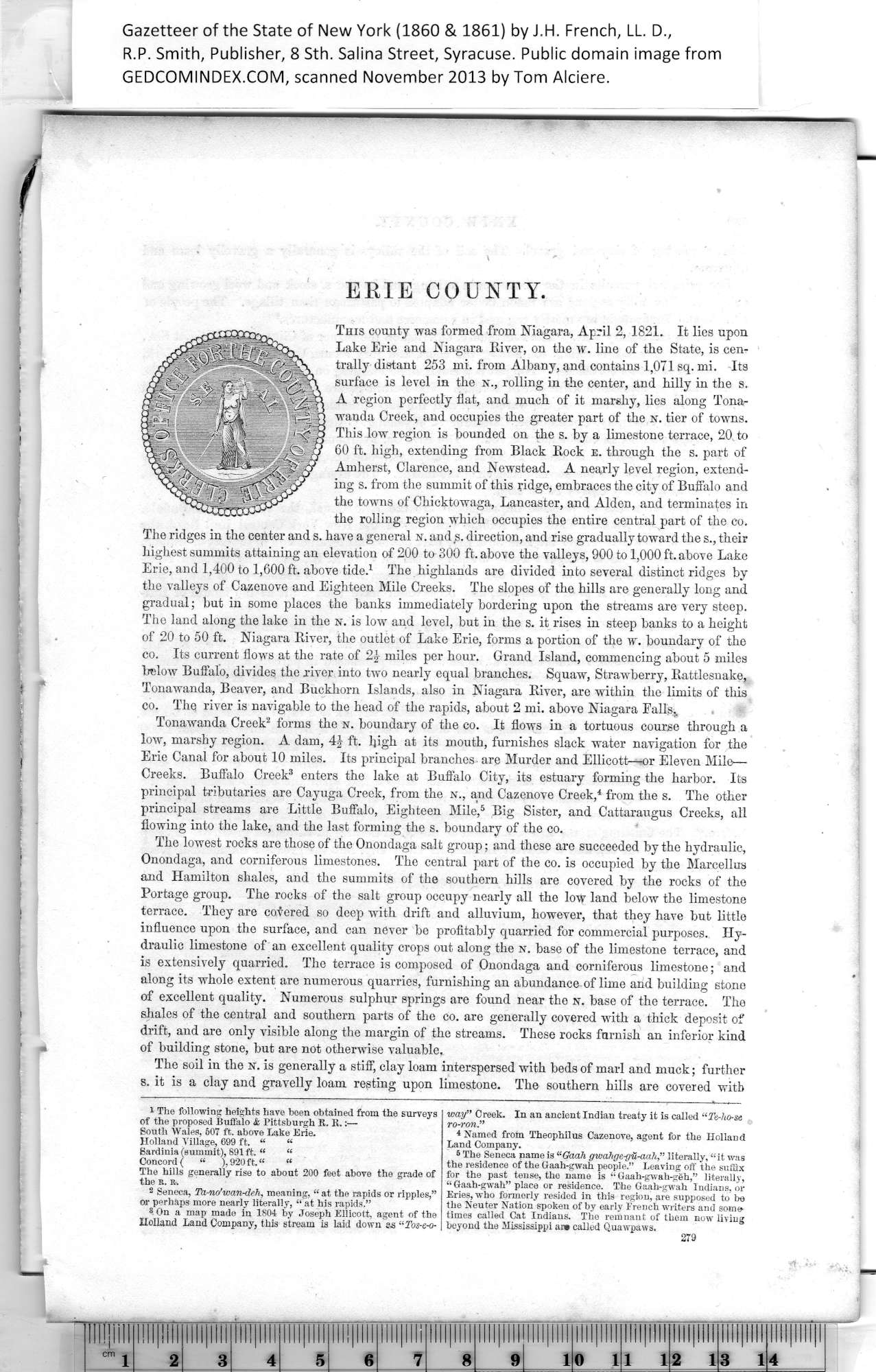|
EEIE COUNTY.
This county was formed from Niagara, April 2, 1821. It lies upon
Lake Erie and Niagara River, on the w. line of the State, is cen?
trally distant 253 mi. from Albany, and contains 1,071 sq. mi. Its
surface is level in the n., rolling in the center, and hilly in the s.
A region perfectly flat, and much of it marshy, lies along Tona¬
wanda Creek, and occupies the greater part of the n. tier of towns.
This low region is bounded on the s. by a limestone terrace, 20 to
60 ft. high, extending from Black Rock e. through the s. part of
Amherst, Clarence, and Newstead. A nearly level region, extend¬
ing s. from the summit of this ridge, embraces the city of Buffalo and
the towns of Chicktowaga, Lancaster, and Alden, and terminates in
the rolling region which occupies the entire central part of the co.
The ridges in the center and s. have a general n. and s. direction, and rise gradually toward the s., their
highest summits attaining an elevation of 200 to 300 ft. above the valleys, 900 to 1,000 ft. above Lake
Erie, and 1,400 to 1,600 ft. above tide.1 The highlands are divided into several distinct ridges by
the valleys of Cazenove and Eighteen Mile Creeks. The slopes of the hills are generally long and
gradual; but in some places the banks immediately bordering upon the streams are very steep.
The land along the lake in the n. is low and level, but in the s. it rises in steep banks to a height
of 20 to 50 ft. Niagara River, the outlet of Lake Erie, forms a portion of the w. boundary of the
co. Its current flows at the rate of 2| miles per hour. Grand Island, commencing about 5 miles
below Buffalo, divides the river into two nearly equal branches. Squaw, Strawberry, Rattlesnake,
Tonawanda, Beaver, and Buckhorn Islands, also in Niagara River, are within the limits of this
co. The river is navigable to the head of the rapids, about 2 mi. above Niagara Falls.,
Tonawanda Creek2 forms the n. boundary of the co. It flows in a tortuous course through a
low, marshy region. A dam, 4} ft. high at its mouth, furnishes slack water navigation for the
Erie Canal for about 10 miles. Its principal branches are Murder and Ellicott—or Eleven Mile—
Creeks. Buffalo Creek3 enters the lake at Buffalo City, its estuary forming the harbor. Its
principal tributaries are Cayuga Creek, from the n., and Cazenove Creek,4 from the s. The other
principal streams are Little Buffalo, Eighteen Mile,5 Big Sister, and Cattaraugus Creeks, all
flowing into the lake, and the last forming the s. boundary of the co.
The loAvest rocks are those of the Onondaga salt group; and these are succeeded by the hydraulic,
Onondaga, and corniferous limestones. The central part of the co. is occupied by the Marcellus
and Hamilton shales, and the summits of the southern hills are covered by the rocks of the
Portage group. The rocks of the salt group occupy nearly all the low land below the limestone
terrace. They are covered so deep with drift and alluvium, however, that they have but little
influence upon the surface, and can never be profitably quarried for commercial purposes. Hy¬
draulic limestone of an excellent quality crops out along the n. base of the limestone terrace, and
is extensively quarried. The terrace is composed of Onondaga and corniferous limestone; and
along its whole extent are numerous quarries, furnishing an abundance-of lime and building stone
of excellent quality. Numerous sulphur springs are found near the sr. base of the terrace. The
shales of the central and southern parts of the co. are generally covered with a thick deposit of
drift, and are only visible along the margin of the streams. These rocks furnish an inferior kind
of building stone, but are not otherwise valuable.
The soil in the n. is generally a stiff, clay loam interspersed with beds of marl and muck; further
s. it is a clay and gravelly loam resting upon limestone. The southern hills are covered with
|
way” Creek. In an ancient Indian treaty it is called “Te-ho-se
ro-ron.”
i Named from Theophilus Cazenove, agent for the Holland
Land Company.
8 The Seneca name is “Gaah gwahge-g-H-aa}/,,” literally, “it was
the residence of the Gaah-gwah people.” Leaving off the suffix
for the past tense, the name is “ Gaah-gwah-geh,” literally,
“Gaah-gwah” place or residence. The Gaah-gwah Indians, or
Eries, who formerly resided in this region, are supposed to bo
the Neuter Nation spoken of by early French writers and some
times called Cat Indians. The remnant of them now living
beyond the Mississippi ai» called Quawpaws. |
279
1
The following heights have been obtained from the surveys
of the proposed Buffalo & Pittsburgh E. K.:—
South Wales, 507 ft. above Lake Erie.
Holland Village, 699 ft. “ “
Sardinia (summit), 891 ft. “ “
Concord ( “ ), 920 ft. “ “
The hills generally rise to about 200 feet above the grade of
the R. R.
s Seneca, Ta-no'wan-deh, meaning, “ at the rapids or ripples,”
or perhaps more nearly literally, “ at his rapids.”
s. On a map made in 1804 by Joseph Ellicott, agent of the
Holland Land Company, this stream is laid down as “Tos-e-o-
|
